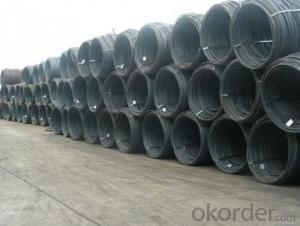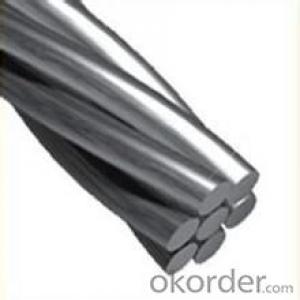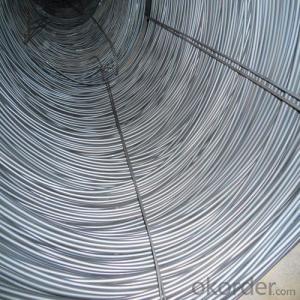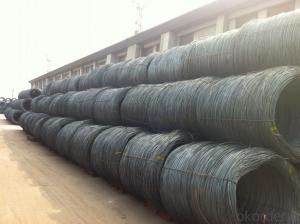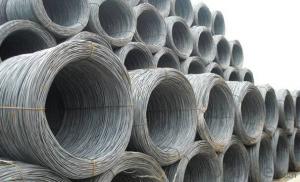Carbon Steel Wire Rod ASTM SAE1008B in High Quality
- Loading Port:
- China Main Port
- Payment Terms:
- TT or LC
- Min Order Qty:
- 100 m.t.
- Supply Capability:
- 10000 m.t./month
OKorder Service Pledge
OKorder Financial Service
You Might Also Like
Product Description:
OKorder is offering Carbon Steel Wire Rod ASTM SAE1008B in High Quality at great prices with worldwide shipping. Our supplier is a world-class manufacturer of steel, with our products utilized the world over. OKorder annually supplies products to African, South American and Asian markets. We provide quotations within 24 hours of receiving an inquiry and guarantee competitive prices.
Product Applications:
Carbon Steel Wire Rod ASTM SAE1008B in High Quality are ideal for structural applications and are widely used in construction and manufacturing. Carbon steel wire rod is mainly used for reinforcement of reinforced concrete and welded structure or reprocessed (roberts , nail, etc.) materials, especially used to produce wire drawing, welding electrode, nails, spring, electronic, precise machinery parts and so on.
Product Advantages:
OKorder's Carbon Steel Wire Rod ASTM SAE1008B in High Quality are durable, strong, and wide variety of sizes.
Main Product Features:
· Premium quality
· Prompt delivery & seaworthy packing (30 days after receiving deposit)
· Can be recycled and reused
· Mill test certification
· Professional Service
· Competitive pricing
Product Specifications:
Steel Grade: SAE1006-1018B
Standard: ASTM, GB
Diameter: 5.5mm, 6.5mm, 7mm,8mm,9mm,10mm,12mm,14mm
Type: in coil, coil weight around 2MT
Alloy or Not: Alloy
Technique: Hot Rolled
Place of Origin: China Mainland
Surface: round, no twisted, light and smooth
Grade | Chemical Composition(%) | |||||
C | Mn | Si | S | P | B | |
SAE1008B | 0.10max | 0.3~O.50 | 0.15max | 0.050max | 0.040 max | 0.0008 min |
Mechanical properties | ||||||
Yield strength(N/mm2) | Tensile strength(N/mm2) | Elongation(%) | ||||
≥195 | 315-430 | ≥30 | ||||
FAQ:
Q1: Why buy Materials & Equipment from OKorder.com?
A1: All products offered byOKorder.com are carefully selected from China's most reliable manufacturing enterprises. Through its ISO certifications, OKorder.com adheres to the highest standards and a commitment to supply chain safety and customer satisfaction.
Q2: How do we guarantee the quality of our products?
A2: We have established an advanced quality management system which conducts strict quality tests at every step, from raw materials to the final product. At the same time, we provide extensive follow-up service assurances as required.
Q3: How soon can we receive the product after purchase?
A3: Within three days of placing an order, we will arrange production. The normal sizes with the normal grade can be produced within one month. The specific shipping date is dependent upon international and government factors, the delivery to international main port about 45-60days.
Images:

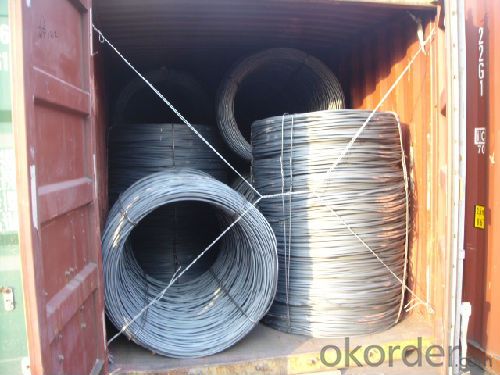
- Q: What are the main factors affecting the market forecasts of steel wire rod?
- The main factors affecting the market forecasts of steel wire rod include global economic conditions, demand from end-use industries such as construction and automotive, raw material prices, government policies and regulations, technological advancements, and competition from alternative materials.
- Q: How is steel wire rod used in the manufacturing of wire forms for automotive seat belts?
- Steel wire rod is used in the manufacturing of wire forms for automotive seat belts as it serves as the primary raw material. The steel wire rod is first drawn into a thinner wire and then formed into various shapes and sizes to create the necessary components of the seat belts, such as buckles, connectors, and retractors. This high-strength material ensures the seat belts can withstand the necessary forces and provide the required safety for passengers in vehicles.
- Q: How are steel wire rods used in the production of reinforcements for concrete?
- The production of reinforcements for concrete heavily relies on steel wire rods. Utilizing high-quality steel, these wire rods undergo a process known as hot rolling to be manufactured. Within the realm of concrete reinforcement production, steel wire rods serve as the building blocks for various types of reinforcements. Wire mesh, rebar, and welded wire fabric are among the creations resulting from these rods. These reinforcements are incorporated into concrete structures to bolster their strength, endurance, and resistance against cracks. To fashion wire mesh, steel wire rods undergo initial straightening, followed by cutting into desired lengths. Subsequently, these lengths are welded together, forming a grid-like pattern. Within the concrete structure, the wire mesh contributes tensile strength, effectively preventing the formation and propagation of cracks. Rebar, another prevalent reinforcement, involves bending and cutting steel wire rods into specific shapes and sizes. These rebars find their place embedded within the concrete, offering structural support and fortifying the concrete against tension forces. Columns, beams, and slabs frequently employ rebars to ensure the soundness of concrete structures. Steel wire rods can also be utilized in the production of welded wire fabric, which constitutes intersecting steel wires. At the points of intersection, the wires are welded together, generating a resilient mesh. Welded wire fabric frequently finds application in larger concrete structures like bridges and highways, effectively distributing loads and averting cracks. In summary, steel wire rods occupy a crucial role in the realm of concrete reinforcement production. By supplying the requisite strength, durability, and crack resistance, these rods guarantee the stability and longevity of concrete structures.
- Q: What are the applications of steel wire rods?
- Steel wire rods are widely used in various applications due to their strength, flexibility, and durability. Some of the common applications of steel wire rods are: 1. Construction: Steel wire rods are extensively used in the construction industry for reinforcing concrete structures. They are used to create steel mesh, stirrups, and rebar, which significantly enhance the strength and stability of concrete buildings, bridges, and other infrastructure. 2. Automotive industry: Steel wire rods are indispensable in the automotive sector. They are used to manufacture springs, suspension systems, tire reinforcement, and seat frames, providing the necessary strength and resilience for various automotive components. 3. Manufacturing: Steel wire rods are utilized in the manufacturing of a wide range of products such as nails, screws, bolts, and wire mesh. These products find applications in the construction industry, furniture manufacturing, and general fabrication processes. 4. Electrical industry: Steel wire rods are employed in the electrical industry for the production of cables and conductors. They form the core of electrical cables, ensuring the efficient transmission of electricity over long distances. 5. Agricultural sector: Steel wire rods are used in the agricultural sector for fencing and animal enclosures. They provide a strong and durable barrier, ensuring the security and safety of livestock and crops. 6. Packaging industry: Steel wire rods are utilized in the packaging industry for the production of wire-based packaging materials such as wire baskets, racks, and crates. These products provide a sturdy and reliable solution for transporting and storing various goods. 7. Wire products: Steel wire rods are also transformed into a wide array of wire products, including wire ropes, springs, piano wires, and welding electrodes. These products find applications in diverse industries such as mining, marine, manufacturing, and construction. In summary, the applications of steel wire rods are vast and diverse, ranging from construction and automotive to manufacturing and electrical industries. Their strength, flexibility, and durability make them indispensable in numerous sectors, playing a crucial role in enhancing the performance and reliability of various products and structures.
- Q: What are the different types of wire drawing dies used for steel wire rod?
- Steel wire rod can be drawn using several types of wire drawing dies. These dies vary in their composition and characteristics. Here are the different types commonly used: 1. Single crystal natural diamond dies: These dies, made from a single crystal diamond, are renowned for their exceptional hardness and resistance to wear. They are suitable for drawing both high carbon steel wire rod and stainless steel wire rod. 2. Polycrystalline diamond (PCD) dies: PCD dies are crafted by bonding multiple small diamond crystals together. They offer good wear resistance and can be used for drawing steel wire rod with intermediate carbon content. 3. Tungsten carbide dies: Utilizing tungsten carbide, a tough and durable material, these dies are often employed for wire drawing. They can handle high carbon steel wire rod and are capable of withstanding high pressures and temperatures. 4. Natural diamond dies with carbide support: These dies possess a core made of natural diamond, providing excellent wear resistance, while a carbide support structure adds strength and stability. They are suitable for drawing steel wire rod with high carbon content. 5. PCD dies with carbide support: Similar to the previous type, these dies have a PCD core and a carbide support structure. They offer good wear resistance and are suitable for steel wire rod with intermediate carbon content. 6. Polycrystalline diamond composite (PDC) dies: PDC dies are manufactured by sintering diamond particles with a binder material. They are well-known for their high wear resistance and are commonly used for drawing steel wire rod with low to medium carbon content. Each type of wire drawing die possesses unique advantages and is suitable for specific applications, depending on the carbon content and other properties of the steel wire rod being drawn.
- Q: How are steel wire rods used in the production of welding electrodes?
- The production of welding electrodes relies heavily on steel wire rods, which serve as vital components. These wire rods function as the central material for welding electrodes, supplying the essential strength and conductivity needed for welding. To initiate the production of welding electrodes, steel wire rods are carefully chosen based on their specific mechanical properties. These properties, such as tensile strength and elongation, guarantee that the welding electrodes can endure the demanding conditions of high temperatures and stress encountered during welding. The steel wire rods then undergo further processing through a series of steps. Initially, they are cleansed and coated with a flux material. This coating aids in the elimination of impurities and facilitates improved arc stability during welding. Moreover, the coating helps create a protective gas shield around the welding area, preventing oxidation and contamination. Once the coating process is complete, the steel wire rods are cut into predetermined lengths and shaped according to the desired electrode design. This may involve bending or forming the rods to achieve the required shape and size for the welding electrode. Once the welding electrode is shaped, it is packaged and prepared for distribution and use. These electrodes find extensive applications in various industries, including construction, automotive, and manufacturing, where they are utilized for welding tasks like metal joining, machinery repair, and structure fabrication. In conclusion, steel wire rods play a critical role in the production of welding electrodes, providing the necessary strength, conductivity, and formability required for these electrodes to effectively carry out welding processes.
- Q: How are steel wire rods stored to prevent corrosion?
- Steel wire rods are typically stored in a way that minimizes exposure to moisture and air, which are the primary causes of corrosion. To prevent corrosion, the rods are usually stored in a dry and well-ventilated area, away from direct contact with the ground and any potential sources of moisture such as water pipes or damp walls. They are often stored on pallets or racks, allowing for proper airflow and preventing contact with any surface that may contain water or excessive humidity. Additionally, steel wire rods are often coated with a protective layer, such as oil or a rust preventive compound, to further safeguard against corrosion during storage. Regular inspections and maintenance are also crucial to ensure that the storage conditions remain optimal and any signs of corrosion are promptly addressed.
- Q: How is the ductility of steel wire rod determined?
- The ductility of steel wire rod is determined through various mechanical tests and measurements. One of the commonly used methods to evaluate ductility is the tensile test. In this test, a sample of the steel wire rod is pulled until it breaks, and the amount of deformation it undergoes before fracture is measured. During the tensile test, the steel wire rod is subjected to an increasing load or force, while its elongation or deformation is continuously measured. The force required to stretch the wire to a specific length is recorded, and the resulting stress-strain curve is plotted. The ductility of the steel wire rod can be determined from this stress-strain curve. The elongation or deformation at the point of fracture is an important parameter in assessing its ductility. Higher elongation indicates greater ductility, as it implies that the material can undergo more deformation before breaking. Apart from the tensile test, other tests such as the bend test and impact test can also be used to evaluate the ductility of steel wire rod. In the bend test, the wire is bent to a specific angle without fracturing. The ability to bend without breaking indicates good ductility. Similarly, the impact test measures the energy absorbed by the wire when it is subjected to a sudden impact. A higher energy absorption indicates better ductility, as it implies that the material can absorb and distribute the impact forces without fracturing. In conclusion, the ductility of steel wire rod is determined through mechanical tests such as the tensile test, bend test, and impact test. These tests measure the amount of deformation the wire can undergo before breaking, the ability to bend without fracturing, and the energy absorption during impact, respectively.
- Q: What are the major factors affecting the supply and demand of steel wire rod?
- The supply and demand of steel wire rod can be affected by various major factors. 1. Economic growth plays a crucial role in determining the demand for steel wire rod. When the economy is growing, there is an increased need for construction, infrastructure development, and manufacturing, all of which require steel wire rod. Conversely, during economic downturns, demand for steel wire rod may decrease as construction projects are put on hold and manufacturing activities slow down. 2. The global production capacity and output levels of steel have a direct impact on the supply of steel wire rod. If there is an increase in steel production, it will result in a larger supply of steel wire rod in the market. Conversely, if steel production declines due to trade restrictions or disruptions in production, the supply of steel wire rod may be limited. 3. The availability and prices of raw materials used in steel wire rod production, such as iron ore and scrap metal, can also affect the supply and pricing of steel wire rod. If the prices of these raw materials increase, it can lead to higher production costs for steel wire rod manufacturers, potentially reducing the supply or increasing the price of the product. 4. Technological advancements in steel wire rod production processes can impact both the supply and demand. Improved production techniques can increase the supply by making the manufacturing process more efficient and cost-effective. Additionally, advancements in steel wire rod applications, such as in the automotive or construction industries, can increase the demand for the product. 5. Trade policies and tariffs imposed by governments can significantly impact the supply and demand of steel wire rod. Tariffs on steel imports can limit the supply of steel wire rod from foreign producers, potentially increasing the demand for domestic manufacturers. On the other hand, reduced trade barriers can increase competition and supply from global markets. 6. Environmental regulations and sustainability initiatives can also influence the supply and demand of steel wire rod. Stricter environmental regulations may require steel wire rod manufacturers to invest in cleaner production methods, potentially increasing production costs and limiting supply. Additionally, the demand for sustainably produced steel wire rod may increase as companies and consumers prioritize environmentally friendly products. In conclusion, the supply and demand of steel wire rod are influenced by a combination of economic factors, technological advancements, raw material availability, trade policies, and environmental considerations. These factors can change over time, leading to fluctuations in the supply and demand dynamics of the steel wire rod market.
- Q: How does the elongation of steel wire rod vary with different wire drawing processes?
- The elongation of a steel wire rod can differ depending on the particular wire drawing process utilized. Wire drawing, a metalworking process that involves pulling a metal wire rod through a series of dies to decrease its diameter and increase its length, can be influenced by various wire drawing processes, such as cold drawing or hot drawing. The elongation of the steel wire rod tends to be greater in hot drawing compared to cold drawing. Hot drawing involves heating the wire rod and then pulling it through the die, which softens the steel and makes it more ductile and easier to deform. Consequently, the wire rod can undergo more elongation without breaking or fracturing. In cold drawing, the steel wire rod experiences less elongation due to its lower ductility at room temperature. The cold drawing process may necessitate multiple passes through different dies to achieve the desired reduction in diameter and increase in length. However, the overall elongation may be relatively lower compared to hot drawing. Furthermore, factors such as the reduction ratio, die design, lubrication, and speed of the wire drawing process can also impact the elongation of the steel wire rod. Higher reduction ratios generally lead to greater elongation. Appropriate die design and lubrication can minimize friction and enhance the wire's ability to elongate. The speed of the wire drawing process can also affect elongation, as excessive speed can cause tension and decrease elongation. In summary, the elongation of a steel wire rod varies depending on the wire drawing process employed. Hot drawing typically allows for greater elongation due to the increased ductility of the steel at higher temperatures, while cold drawing may result in relatively lower elongation. Various process parameters and conditions, such as reduction ratio, die design, lubrication, and speed, also play a significant role in determining the elongation of the wire rod.
Send your message to us
Carbon Steel Wire Rod ASTM SAE1008B in High Quality
- Loading Port:
- China Main Port
- Payment Terms:
- TT or LC
- Min Order Qty:
- 100 m.t.
- Supply Capability:
- 10000 m.t./month
OKorder Service Pledge
OKorder Financial Service
Similar products
Hot products
Hot Searches
Related keywords
